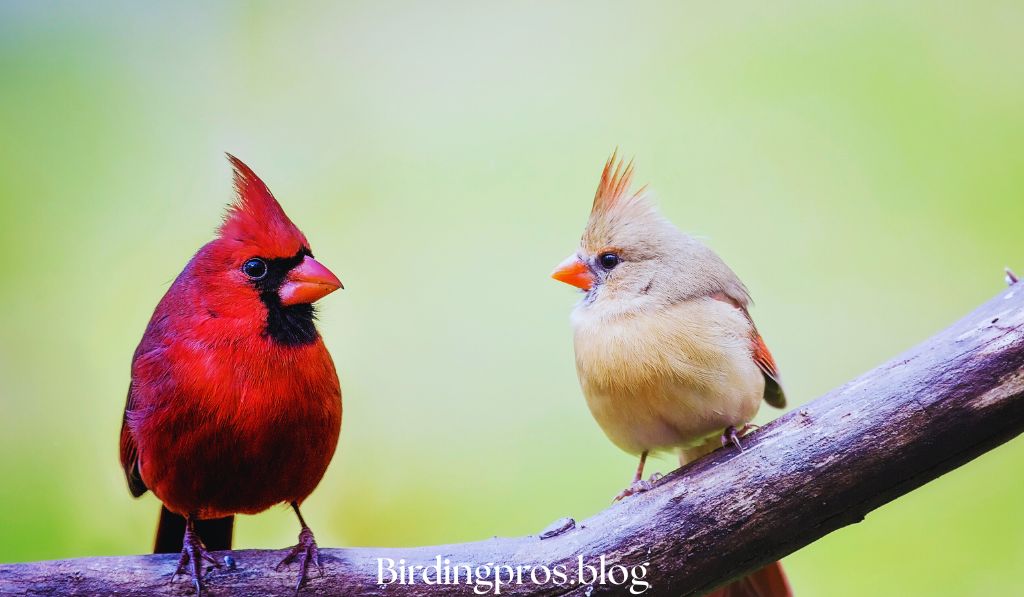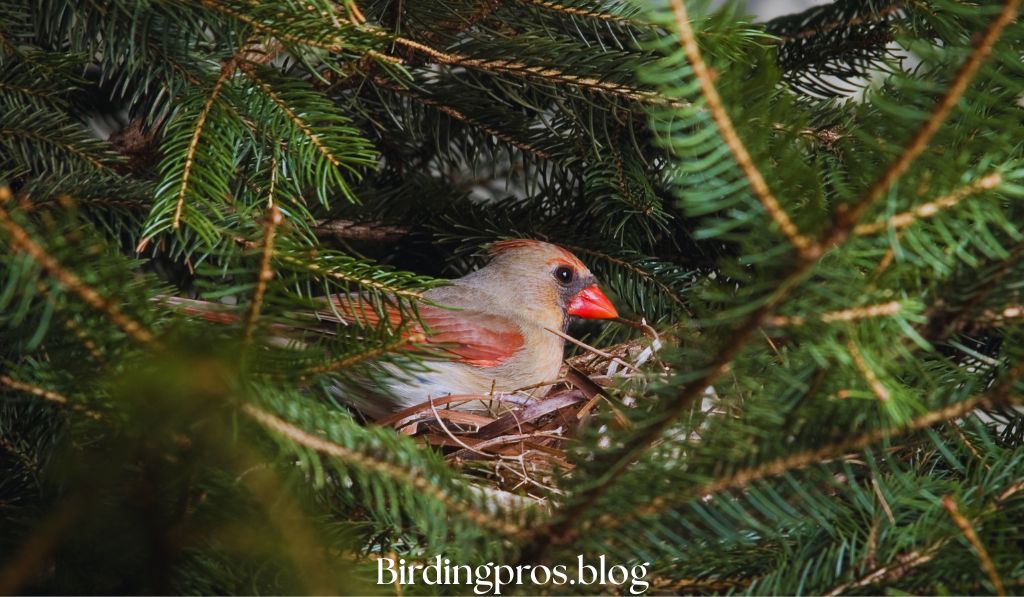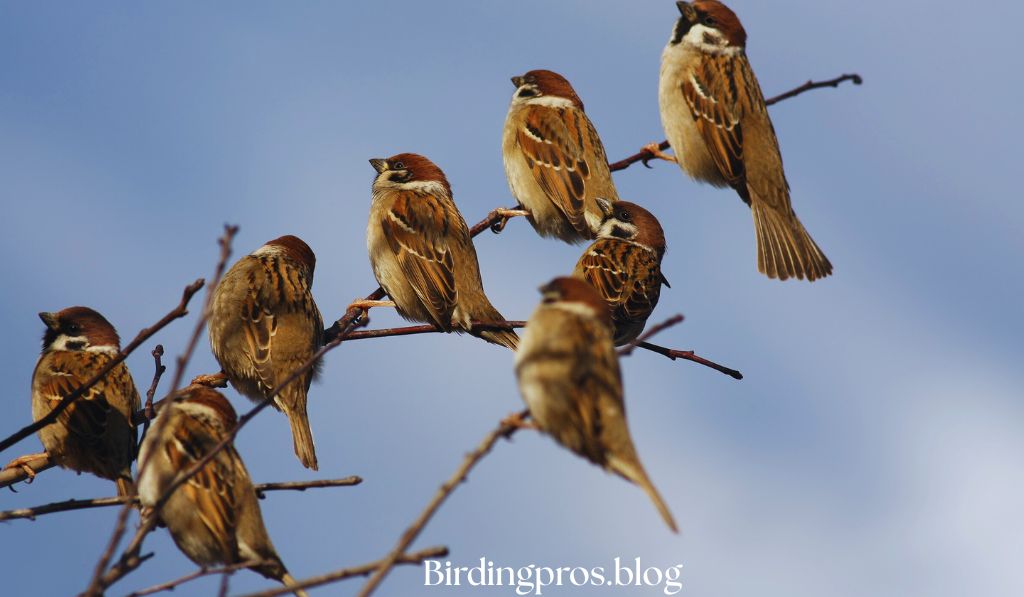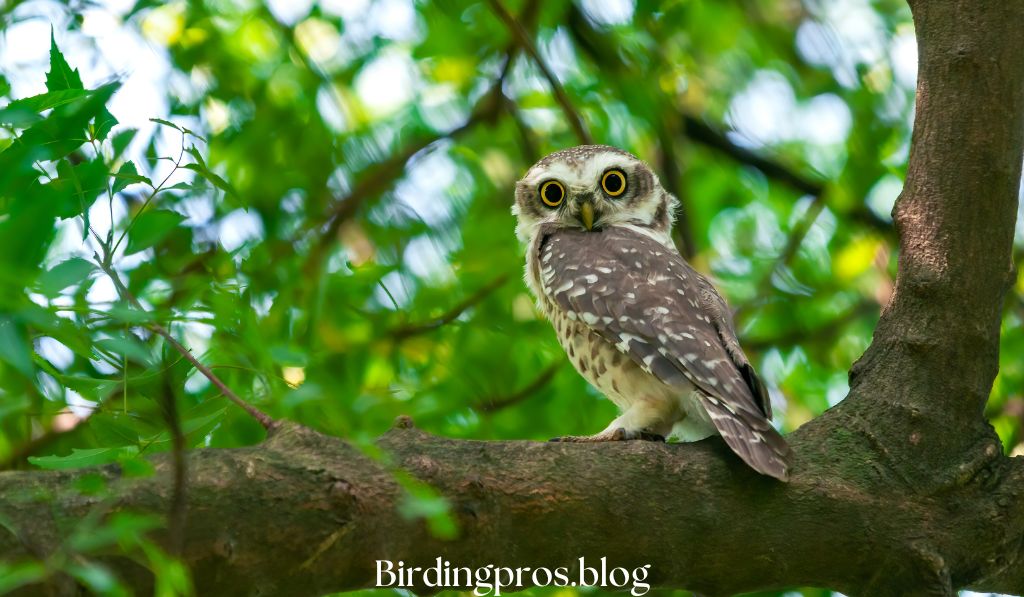Cardinals, with their hanging red plumage and glad songs, are favored site site visitors to backyards at some stage in North America.
As a bird enthusiast, you have probably wondered about their interactions with exceptional avian species, mainly in terms of nesting behaviors. Let’s dive deep into the arena of cardinal behavior to answer this urgent question.
Table of Contents
ToggleCardinals’ Natural Behavior

Understanding the innate behaviors of cardinals enables an explanation for their interactions with exclusive hen species.
Territorial Instincts
As you’ve possibly determined, cardinals show robust territorial tendencies, mainly in the course of breeding season.
Male cardinals vigorously protect their established territory from perceived intruders. You can also have them chasing away other birds that are assigned too close to their nesting sites.
Interestingly, cardinals are so protective in their area that they’ve been regarded to assault their very own reflections in home windows and car mirrors, mistaking the picture for a rival chook.
This behavior demonstrates their dedication to territory protection in preference to an inherent aggressiveness toward other birds’ nests.
When you listen to the awesome whistling name of a male cardinal, you’re witnessing a territorial show. These melodious songs serve as auditory barriers, warning other birds to hold their distance.
Mating Season Activities
During breeding season, you may word a shift in cardinal conduct. Pairs grow to be extra energetic as they put together for nesting and elevating young.
The colourful red male regularly brings food to his mate, a courtship conduct that strengthens their bond and demonstrates his prowess as an agency.
| Behavior | Purpose | Observation |
| Territorial Defense | Protect nesting area | Males chase intruders away |
| Song Production | Mark territory boundaries | Frequent whistling calls |
| Courtship Feeding | Strengthen pair bond | Males bringing food to females |
| Reflection Fighting | Eliminate perceived rivals | Attacking windows and mirrors |
Nest production turns into a collaborative try between the pair. You’ll observe every male and woman cardinals gathering twigs, grass, and leaves to create their cup-common nests.
This teamwork displays their focused funding in their private reproductive fulfillment instead of interference with different species.
While their protecting instincts intensify sooner or later of this era, cardinal aggression is mainly directed towards protecting their mounted territory and nest, no longer actively attacking different birds’ nests.
Habitat and Nesting Preferences

Cardinals have precise necessities for his or her nesting websites that affect their interactions with neighboring birds.
Preferred Nesting Sites
When you explore regions frequented by way of cardinals, you could discover they prefer dense shrubs and thickets that offer concealment from predators.
These birds commonly assemble their nests in places with tremendous cowl—shrubs, small wood, and vine tangles provide exceptional safety.
You’ll usually discover cardinal nests placed among 1 and 15 toes above the ground. This pinnacle desire lets in for a few protection at the same time as keeping accessibility.
The birds skillfully use materials like twigs, bark strips, and grass to gather strong nests that mix with their surroundings.
Seasonal Nesting Patterns
If you display cardinal interest sooner or later of the 12 months, you can word remarkable nesting cycles. These birds generally start their breeding sports in early spring, commonly March in maximum areas.
| Season | Nesting Activity | Behavioral Changes |
|---|---|---|
| Early Spring | Initial nest building | Increased territoriality |
| Late Spring | First clutch of eggs | Heightened nest defense |
| Early Summer | Rearing first brood | Focused feeding activity |
| Mid-Summer | Second or third clutches | Continued vigilance |
| Late Summer | Final broods | Preparing juveniles for independence |
Female cardinals are prolific breeders, generating more than one clutches each season. You can anticipate to discover 3-four eggs in every snatch, with the breeding length extending from March through August.
This extended reproductive window gives the younger sufficient development time in advance when a less warm climate arrives.
During this important nesting period, your observations will display heightened vigilance amongst cardinal pairs.
They end up specifically protective of their nests, showing protective behaviors toward any perceived threats. This defensive stance is directed at safeguarding their offspring rather than attacking special birds’ nests.
Interactions With Other Birds

Cardinals coexist with numerous birds species in shared habitats. Understanding those relationships provides a notion into their nest-associated behaviors.
Common Neighbors
In your outdoor or close by park, you’ve in all likelihood seen cardinals sharing space with species like sparrows, chickadees, and robins.
These birds frequently occupy the same popular territories without massive struggle.
| Bird Species | Interaction Level | Territorial Overlap |
|---|---|---|
| Sparrows | Peaceful coexistence | High |
| Chickadees | Limited interaction | Moderate |
| Robins | Occasional minor disputes | Medium |
| Blue Jays | Avoidance behaviors | Low |
| Woodpeckers | Minimal interaction | Very Low |
Cardinals typically preserve peaceful relationships with most smaller songbirds. You’ll take a look at them feeding alongside these species without obvious aggression.
However, at the same time as large or more competitive birds like blue jays input their territory, cardinals may also display defensive posturing.
The relationships among cardinals and their avian pals showcase their usually non-confrontational nature with regards to other species’ nesting websites.
Social Hierarchy
Unlike a few fowl species that shape big flocks, you’ll note cardinals select a less difficult social structure.
They usually stay as mated pairs or small own family agencies, focusing their attention on their at once territory in location of putting in complicated hierarchies.
Male cardinals take number one obligation for territory protection, whilst girls are aware of nesting and chick-rearing sports.
This division of tough work lets the pair successfully defend their private nesting pastimes without expanding energy interfering with different birds.
Though male males may be assertive in chasing away perceived threats in the course of breeding season, your observations will affirm they rarely have interaction in direct assaults on one-of-a-kind birds’ nests.
Their defensive strategy centers on preserving territorial limitations in place of becoming nest predators.
Do Cardinals Build Their Own Nests?
Understanding cardinal nesting conduct is essential to addressing misconceptions approximately their interactions with one-of-a-kind birds.
Nest Construction Process
When you look at cardinals at some stage in the breeding season, you can see they’re committed nest builders.
The female takes the lead in advent, at the same time as the male provides materials and stands guard.
Their nests are remarkably nicely-crafted, proposing an outer body of twigs, a center layer of leaves and bark, and a clean inner lining of grass and animal hair.
| Nest Component | Materials Used | Construction Role |
|---|---|---|
| Outer Frame | Twigs, small branches | Structural support |
| Middle Layer | Leaves, bark strips | Insulation and protection |
| Inner Cup | Soft grass, animal hair | Comfort for eggs and nestlings |
| Camouflage | Lichens, plant fibers | Visual concealment |
Cardinals invest big electricity in constructing their personal nests rather than usurping the ones of different birds.
You’ll find they commonly complete nest production in 3-nine days, demonstrating their efficiency and commitment to developing their own nesting web sites.
Nest Location Strategy
As you music cardinal nesting behavior, you may find out they strategically pick websites that offer pinnacle-great safety.
Dense vegetation with thorny branches often serves as their desired place, imparting natural defenses towards predators.
Cardinals pick nesting web sites that allow for short get admission to and go out routes. This tactical positioning allows the birds to escape fast if threatened and gives more than one technique for feeding their younger.
Their funding in nest web page selection further demonstrates their attention on their own reproductive fulfillment in preference to interfering with different birds’ nests.
Instances Of Nest Raiding
Examining the proof concerning cardinals and nest raiding behaviors is a famous crucial insight.
Documented Cases
When you study clinical literature and birdwatching records, you may discover incredibly few documented instances of cardinals raiding other birds’ nests.
The rare instances that exist usually comprise uncommon events such as excessive food shortages or habitat disruption.
Expert ornithologists document that nest raiding conduct is not a feature of cardinals. Your private observations will in all likelihood confirm that the birds recognize their private territories and meals assets in choice to focus on specific birds’ nests for eggs or nestlings.
Mistaken Identity
In a few instances, you could pay interest evaluations of “cardinals” attacking nests, but cautious studies frequently show well-known instances of improper identification.
Birds like blue jays and cowbirds, which can be acknowledged nest predators, are every now and then pressured with cardinals by the usage of casual observers.
| Bird Species | Nest Predation Tendency | Identifying Features |
|---|---|---|
| Cardinals | Very Low | Bright red plumage, crest, black face |
| Blue Jays | High | Blue coloration, loud calls, aggressive behavior |
| Cowbirds | Very High | Brown-black coloration, brood parasites |
| Grackles | Moderate | Iridescent black plumage, yellow eyes |
When comparing such claims, examine the specifics of the stated conduct. Cardinals more frequently than no longer consume seeds, fruits, and insects—not eggs or nestlings—which in addition allows their non-predatory dating with different birds’ nests.
Diet And Feeding Habits
A fowl’s food regimen strongly affects its behavior within the route of various species and their nests.
Typical Diet
As a professional birds watcher, you’ve in all likelihood determined cardinals’ feeding possibilities.
These birds hold a more often than not vegetarian weight loss plan, with seeds constituting approximately 70% in their food intake. Sunflower seeds, safflower seeds, and diverse grains make up the majority of their vitamins.
Cardinals supplement their seed consumption with ceaseless end results like blackberries, mulberries, and wild grapes.
You’ll note additionally they devour insects, especially inside the direction of breeding season whilst protein necessities growth. Their natural weight loss program provides little motivation for nest raiding, in evaluation to birds that frequently consume eggs and nestlings.
Seasonal Variations
Your one year-spherical observations will display how cardinals regulate their weight loss plan in line with seasonal availability.
During spring and summer time months, they increase their intake of insects and caterpillars. This protein-wealthy eating regimen helps the nutritional desires in their developing chicks.
In fall and wintry weather, you may see cardinals shift to a higher proportion of seeds and berries. They frequently go to bird feeders at some stage in much less heat months even as natural meals assets come to be scarcer.
These seasonal nutritional patterns display how cardinals meet their nutritional goals through effortlessly available food belongings rather than targeting different birds’ nests.
Protective Measures
Cardinals lease various strategies to protect their non-public nests, supplying perception into their normal approach to territory defense.
Defensive Strategies
When you observe cardinal nesting behavior, you may have to study numerous safety tactics.
Their preference for dense, thorny vegetation creates natural boundaries towards ability predators. This planned nest placement demonstrates their attention on defensive in place of offensive behaviors.
Cardinals use distraction shows to guard their nests even as threatened. You would possibly witness a cardinal feigning injury to draw predators far from the nest area.
These sophisticated protection mechanisms spotlight their investment in protecting their very very own nests in place of threatening those of different species.
Alarm Calls
Listen carefully near cardinal territories, and you may come across their unique alarm calls while threats technique.
Both men and women emit sharp “chip” sounds to alert their partner and neighboring birds to functionality risks.
These alarm communications serve a couple of purposes inside the chook community. Not best do they warn the cardinal’s circle of relatives, however additionally they inadvertently benefit different birds species in the vicinity.
This cooperative detail of their communication tool further illustrates cardinals’ feature inside the birds network as non-threatening associates.
Impact Of Environment
Environmental factors notably have an effect on cardinal conduct closer to other birds and their nests.
Urban Vs. Rural Settings
Your observations throughout unique environments will display how habitat impacts cardinal behavior.
In metropolis settings with restricted resources and nesting web sites, territorialism may increase. However, this typically manifests as defense of their own area instead of aggression towards distinctive birds’ nests.
In rural regions with plentiful assets, you may phrase cardinals preserve greater comfortable territorial barriers. The availability of nesting web sites and food resources reduces opposition and ability for conflict.
This environment has an effect on confirming that cardinal aggression is contextual and useful resource-mounted in place of predatory.
Climate Influence
As you sing cardinal conduct throughout seasons, you may phrase climate influences their interactions with different birds.
In areas with shorter breeding seasons, territorial protection will become extra focused and severe in the course of that confined period.
Conversely, in areas with prolonged heat seasons, breeding activities unfold over a prolonged time frame, likely reducing the depth of territorial behaviors.
These weather-pushed behavioral styles reflect cardinals’ version to environmental conditions in preference to inherent aggression closer to other species’ nests.
Role Of Predators
Understanding the predator-prey dynamics enables contextualizing cardinals’ features within the atmosphere.
Common Predators
As you display nesting birds, you will understand the real threats to eggs and nestlings. Snakes, raccoons, squirrels, and large birds of prey represent the primary dangers to birds nests.
These regarded nest predators have advanced unique variations for getting access to and ingesting eggs and more youthful birds.
Cardinals, with the aid of way of evaluation, lack the physical versions and behavioral styles associated with nest predation.
Their beaks are specialized for seed intake in areas of predatory sports activities, similarly confirming their non-threatening relationship with exceptional birds’ nests.
Defense Mechanisms
When you study birds’ responses to nest predators, you may examine how one among a kind species have advanced numerous protection techniques.
Community nesting, mobbing behaviors, and alarm systems all serve to counter actual threats.
Cardinals take part in the ones community defense systems via the usage of their alarm calls while predators approach.
This cooperative conduct demonstrates their feature as allies in the vicinity of threats in the chook community’s defense in the direction of actual nest predators.
Birdwatchers’ Observations
The collective experience of committed birdwatchers gives valuable insights into cardinal conduct.
Field Reports
When you connect with the birdwatching community, you’ll find ordinary reviews regarding cardinal behavior. Experienced observers always word cardinals’ focus on defending their very personal nests as opposed to attacking others.
These firsthand money owed from lots of hours of statements offer compelling proof of cardinals’ non-predatory nature.
Citizen era initiatives monitoring hen behaviors have amassed incredible statistics on interspecies interactions.
These systematic observations in addition assist the notion that cardinals hardly ever, if ever, engage in nest raiding behaviors.
Citizen Science Contributions
Your participation in citizen generation tasks like Project FeederWatch or NestWatch contributes to our expertise of cardinal behavior.
These packages have gathered many years of information showing cardinals peacefully coexisting with numerous fowl species.
The collective observations documented through these programs provide statistical aid for what man or woman birdwatchers record: cardinals recognize their electricity on building and protect their very own nests in place of interfering with the ones of various birds.
Expert Perspectives
Ornithologists and ethologists offer scientific insights into cardinal conduct based totally on systematic observation.
Ornithologists’ Insights
Leading fowl researchers verify that cardinals showcase territorial conduct typically centered on protecting their immediate surroundings.
Their studies display that cardinals lack the behavioral and physical versions related to nest predation.
Research on cardinal diet composition in addition allows this end, showing that eggs and nestlings no longer represent part of their ordinary meals assets.
This clinical proof aligns with casual observations that cardinals pose minimal threat to special birds’ nests.
Ethologists’ Perspectives
Animal conduct experts are conscious that cardinal aggression serves particular evolutionary purposes related to aid protection and mate choice.
These behaviors follow predictable patterns that do not consist of systematic attacks on different species’ nests.
Ethologists’ comparative research of nest predators as opposed to territorial defenders clearly area cardinals inside the latter elegance.
Their research confirms that cardinals’ interactions with special birds middle on setting up territory limitations in preference to predatory behavior.
Conservation Efforts
Understanding species interactions informs effective conservation practices.
Cardinals Vs. Other Birds
When you compare cardinals to identified nest predators like blue jays and crows, you may take a look at vital variations in conduct.
Cardinals lack the opportunistic feeding styles and nest-raiding behaviors feature of those species.
Your conservation efforts want to understand those behavioral differences. While some fowl species require control to guard inclined nesting birds, cardinals commonly make a contribution surely to outdoor bird variety without threatening other species’ reproductive fulfillment.
Aggression Levels
As you examine bird interactions, you may be aware cardinals show moderate territorial aggression in contrast to other species.
This aggression is context-particular, intensifying during breeding season and focusing usually on equal-species competitors in desire to different birds’ nests.
Understanding these aggression patterns enables you to create bird-high-quality environments that accommodate a couple of species.
By providing ok spacing between nesting web web sites and vast food sources, you could reduce territorial conflicts at the same time as supporting various hen populations.
Conclusion
The evidence overwhelmingly indicates that cardinals do no longer typically assault special birds’ nests.
Their territorial behaviors rely on shielding their very own nesting web websites and meals assets in preference to interfering with different species’ reproduction.
As you maintain gazing at these stunning birds, you’ll respect their role as generally non violent contributors of the outdoor fowl community.
By information cardinal conduct, you can better assist those lovely birds via suitable habitat introduction and conservation practices.
Their vibrant presence complements any environment, bringing coloration and song without threatening other avian associates.






